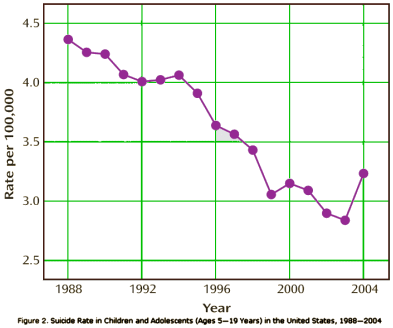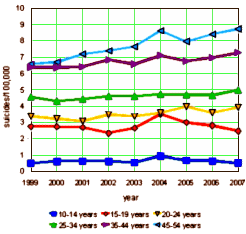Study questions antidepressant link to suicide in kids
Los Angeles Times
By Shari Roan
February 06, 2012
In 2004, the Food and Drug Administration announced that antidepressant packages should carry a "black box" warning describing an increased risk of suicide and suicidal thoughts in children and youths up to age 25. The FDA action triggered a significant decline in antidepressant use among children and teens. Now, however, an analysis suggests there is no reason to believe that antidepressants influence suicidal thinking in kids.The paper, published online Monday in the Archives of General Psychiatry, analyzed data from 41 clinical trials involving more than 9,000 adults and children. The adults were taking either the antidepressant fluoxetine or venlafaxine. The children were taking fluoxetine (Prozac). The study showed that adults had a decreased risk of suicidal thoughts and behaviors while taking an antidepressant. Among children, medications neither increased nor decreased suicidal thoughts or behavior.
The new study draws from a larger database than the research performed in 2004 that led to the "black box" warning. However, the data on children are limited to the one medication – fluoxetine. Several important points can be drawn from the new study, said the lead author of the paper, Robert Gibbons, a professor of medicine, health studies and psychiatry at the University of Chicago. It suggests that antidepressants reduce suicide rates by treating the underlying depression. If the treatment does not work, suicide risk remains the same or rises.
Moreover, antidepressants appear to affect children differently than adults with regard to suicide. "Maybe children think about suicide in part because of depression, but also maybe due to other reasons not related to depression that are not affected by antidepressants," Gibbons said in a news release. The impact of the "black box" warning, he said, was to reduce antidepressant prescriptions to kids – which was correlated with an increase in suicide rates in subsequent years.
"I hope that the warnings will not prevent depressed children and adults from getting treatment for depression," he said. "The greatest cause of suicide is untreated or undiagnosed depression. It’s very important that this condition be recognized and appropriately treated and not discarded because doctors are afraid to be sued."
-
The relationship between antidepressant medication use and rate of suicide.
by Gibbons RD, Hur K, Bhaumik DK, Mann JJ.
Arch Gen Psychiatry. 2005 Feb;62(2):165-72. -
The relationship between antidepressant prescription rates and rate of early adolescent suicide.
by Gibbons RD, Hur K, Bhaumik DK, Mann JJ.
Am J Psychiatry. 2006 Nov;163(11):1898-904. -
Association of suicide and antidepressant prescription rates in Japan, 1999-2003.
by Nakagawa A, Grunebaum MF, Ellis SP, Oquendo MA, Kashima H, Gibbons RD, Mann JJ.
J Clin Psychiatry. 2007 Jun;68(6):908-16. -
Relationship between antidepressants and suicide attempts: an analysis of the Veterans Health Administration data sets.
by Gibbons RD, Brown CH, Hur K, Marcus SM, Bhaumik DK, Mann JJ.
Am J Psychiatry. 2007 Jul;164(7):1044-9. -
Early evidence on the effects of regulators’ suicidality warnings on SSRI prescriptions and suicide in children and adolescents. [see peaks and valleys…]
by Gibbons RD, Brown CH, Hur K, Marcus SM, Bhaumik DK, Erkens JA, Herings RM, Mann JJ.
Am J Psychiatry. 2007 Sep;164(9):1356-63.


-
The role of randomized trials in testing interventions for the prevention of youth suicide.
by Brown CH, Wyman PA, Brinales JM, Gibbons RD.
Int Rev Psychiatry. 2007 Dec;19(6):617-31. -
Mixed-effects Poisson regression analysis of adverse event reports: the relationship between antidepressants and suicide.
by Gibbons RD, Segawa E, Karabatsos G, Amatya AK, Bhaumik DK, Brown CH, Kapur K, Marcus SM, Hur K, Mann JJ.
Stat Med. 2008 May 20;27(11):1814-33. -
Post-Approval Drug Safety Surveillance.
by Robert D. Gibbons, Anup K. Amatya, C. Hendricks Brown, Kwan Hur, Sue M. Marcus, Dulal K. Bhaumik, and J. John Mann.
Annual Review of Public Health 2010 31:419-437. -
Strategies for quantifying the relationship between medications and suicidal behaviour: what has been learned?
by Gibbons RD, Mann JJ.
Drug Saf. 2011 May 1;34(5):375-95.
-
Suicidal Thoughts and Behavior With Antidepressant Treatment
Reanalysis of the Randomized Placebo-Controlled Studies of Fluoxetine and Venlafaxine
by Robert D. Gibbons, Hendricks Brown, Kwan Hur, John M. Davis, and J. John Mann
Archives of General Psychiatry. Online February 6, 2012. [full text on-line]
Dr. David Healy who has been in the eye of this storm from the start has a lot to say about this paper [Coincidence a fine thing], and I expect will have even more to say as things progress [it’s one of the central topics of his new book, Pharmageddon]. He points to Gibbons’ use of rating scale numbers to indicate suicidal ideation, a heavily debunked method discarded long ago. He has a story about Gibbons’ coauthor on another paper disavowing it. And, of course, there are the observations of Göran Högberg [covered in significant I…, significant II…, and significant III…]. But as usual, Healy should be read as a primary source, not in camera.
More on real suicide data, TADS study –
http://www.psychologytoday.com/blog/mad-in-america/201202/the-real-suicide-data-the-tads-study-comes-light
Duane
What are your qualifications to writer on medical matters?
old doctor…
Those sets of pubs using the same authors over and over, covering the same subject from different angles, in different journals over a relatively short period of time–that all screams pub plan to me, from every angle, as in pharma funding and ghost writers.